5 Questions to Consider When Selecting UV or UV Vis Sensors
(Updated May 2025)
Since its adaptation to online instrumentation, spectrophotometry is critical to monitoring and controlling our water and wastewater treatment facilities. Spectrophotometry, a method for measuring the amount of light absorbed by a type of molecule, has become increasingly accurate and reliable with these online sensors.
The YSI IQ SensorNet family of ultraviolet (UV) and ultraviolet visible (UV Vis) sensors has built-in factory calibrations for specific wastewater treatment applications, increasing accuracy and reducing the necessity for frequent calibration. Maintenance is reduced to a minimum with built-in UltraClean ultrasonic cleaning, less frequent calibrations, and the elimination of replaceable wear items, such as reagents or wipers. (Learn more with this video, YSI IQ SensorNet UV Vis Ultrasonic Cleaning with UltraClean Technology). These sensors even have the capability of measuring several different parameters with a single sensor, such as nitrate, nitrite, total suspended solids (TSS), ultraviolet transmittance (UVT-254), color, chemical oxygen demand (COD), biological oxygen demand (BOD), total organic carbon (TOC) and several other carbon parameters.
These sensors are an important investment for water and wastewater treatment facilities and provide many benefits to operators, but there are several different options to consider when choosing a sensor. To ensure you choose the correct sensor for your application, let’s take a look at 5 questions to consider when selecting a UV Vis sensor.
UV & UV Vis Sensor Benefits
|
1
|
Reagentless online measurement of Nitrate, Nitrite, COD, BOD, TOC, UVT-254, NOx, TSS, and color
|
|
2
|
Measurement and display of up to five parameters on single sensor
|
|
3
|
UltraClean ultrasonic cleaning technology prevents fouling and lowers maintenance requirements
|
|
4
|
Durable, long lasting materials: Titanium and PEEK will hold up in the toughest conditions
|
|
5
|
UV and UV Vis spectral sensors scan 256 wavelengths per measurement for better accuracy and turbidity compensation
|
|
6
|
Factory calibrated for location in the process (influent, secondary treatment, effluent)
|
|
7
|
User calibration possible for improved accuracy in non-ideal applications
|
Parameters
|
Nitrate (NO3-)
|
Biological pollutant from human waste converted from NH4+ in the nitrification process.
|
|
Nitrite (NO2-)
|
Biological pollutant from human waste, the intermediate form between NH4+ and NO3- in the nitrification process.
|
|
Chemical Oxygen Demand (COD)
|
The amount of oxygen consumed by all the reactions within a sample. It is considered a quantification of the organic matter present and commonly used as a surrogate to the BOD measurement.1
|
|
Biochemical Oxygen Demand (BOD)
|
The amount of oxygen consumed by microorganisms in breaking down organic waste in stream water. It is considered a quantification of organic matter present and is regulated with effluent limitations by the National Pollution Discharge Elimination System (NPDES).1
|
|
Total Organic Carbon (TOC)
|
The amount of organically bound carbon in a sample. It is considered a quantification of the organic matter present and an indicator of water quality. This test is often used as a more convenient and direct expression of organic matter than BOD or COD.1
|
|
UVT% (UVT-254)
|
The percentage of UV light transmitted at the 254nm wavelength. This parameter is used as an indication of the organic content within the water and is often correlated with BOD, COD, and TOC. It is commonly measured to automatically control UV dosing in the disinfection process.1
|
|
Total Suspended Solids (TSS)
|
The dry weight of the suspended particles in a sample of water that can be trapped by a filter. This parameter is often used as an indicator of water quality and as a quantification of the microorganisms present in activated sludge systems (Mixed Liquor Suspended Solids, MLSS).1
|
|
Color (Pt/Co)
|
The perceived color of water, expressed as a Hazen color number (Pt/Co). Online color measurement can indicate industrial contamination, chemical breakthrough, or changes in water quality in surface and treated waters.
|
1(APHA, 1995)
1) What Do I Want to Measure and Why?
When selecting a UV or UV Vis sensor, you first and foremost need to know what and why. What parameters do you want to measure? What is the application? How will the sensor be used? Depending on the application, it may even be beneficial to monitor multiple parameters on a single sensor. Here are some of the most common applications for UV Vis sensors in wastewater treatment.
>>> For more guidance on selecting the right sensor, reference the IQ SensorNet UV & UV-Vis Application Guide.
Nitrogen
The nitrogen parameters, nitrate and nitrite, are commonly measured in biological nutrient removal (BNR) applications. (Learn more in this on-demand webinar, Biological Nutrient Removal of Nitrogen). Nitrate can provide several opportunities for process optimization, such as ensuring efficient completion of nitrification, monitoring nitrate removal, controlling carbon dosing in anoxic zones, and ensuring effluent compliance with nitrogen limits. Nitrite is less often measured as it is the intermediate stage of the nitrification process. Monitoring nitrite may be beneficial if a wastewater facility has an issue with nitrite accumulation or is utilizing a shortcut denitrification process.
Carbon
Carbon parameters also offer a wide variety of opportunities for use within wastewater treatment. COD, BOD, and TOC are common measurements for quantifying the carbon within a sample, with BOD and TOC being specific to organic carbon. For instance, COD is commonly measured in secondary treatment for organic load monitoring. In secondary treatment, COD can indicate the efficiency of primary or secondary treatment or quantify the amount of organic carbon present for a biological process that requires a carbon source (denitrification and phosphorus removal). In addition, monitoring COD in the collection system or headworks of a wastewater treatment plant can help determine the source of heavy loads or provide early warning detection.
These carbon parameters have historically required expensive or time-consuming lab procedures, making them impractical to put in use. Today, the development of online UV Vis sensors has led to these parameters being used for process control and early warning detection applications, which would otherwise be unmanageable. There are many possible applications for UV and UV Vis sensors and some instances where multiple parameters on a single sensor can be beneficial to the operator.
As an example, TSS is a common measurement within aeration basins that indicates the concentration of microorganisms present (MLSS – mixed liquor suspended solids). Utilizing a sensor that includes TSS in combination with COD would give an operator the necessary information for monitoring the food to microorganism ratio (F/M ratio). Monitoring several parameters with a single sensor can provide additional value by acquiring more useful data from a single sensor. Make sure to refer to the list of parameters available for each sensor when choosing a UV Vis sensor (Table 1).

|
Sensor Type
|
Gap Widths (mm)
|
Total Parameters
|
Carbon Sum Parameters
|
Nitrate
|
TSS
|
Nitrite
|
SAC, UVT
|
NOx
|
Color
|
|
Spectral Sensors
|
|
|
CarboVis
|
1, 5
|
5
|
•
|
|
|
|
|
|
|
|
CarboVis TS
|
1, 5
|
5
|
•
|
|
•
|
|
|
|
|
|
CarboVis TS Co
|
5
|
5
|
•
|
|
•
|
|
|
|
•
|
|
NitraVis
|
1, 5
|
5
|
|
•
|
|
|
|
|
|
|
NitraVis TS
|
1, 5
|
5
|
|
•
|
•
|
|
|
|
|
|
NitraVis NI
|
1, 5
|
5
|
|
•
|
|
•
|
|
|
|
|
NiCaVis
|
5
|
5
|
•
|
•
|
|
|
|
|
|
|
NiCaVis TS Co
|
5
|
5
|
•
|
•
|
•
|
|
|
|
•
|
|
NiCaVis NI
|
1, 5
|
5
|
•
|
•
|
|
•
|
|
|
|
|
ColorVis
|
5
|
2
|
|
|
|
|
|
|
•
|
|
Single-wavelength Sensors
|
|
|
SAC
|
1, 5
|
1
|
•
|
|
|
|
•
|
|
|
|
NOx
|
1, 5
|
1
|
|
|
|
|
|
•
|
|
Table 1. IQ SensorNet UV Vis Spectrophotometer Sensor Types
2) What’s the Difference Between Single-Wavelength and Spectral Sensors?
Some manufacturers only have single-wavelength sensors where others like YSI have single-wavelength and spectral sensors which offer more parameters and higher accuracy. Previously, we have been discussing the spectral sensors in which 256 wavelengths of UV and visible light are scanned per measurement to get a concentration of your desired parameter. These sensors measure absorbance at each wavelength to produce a ‘spectral footprint’. Each ‘spectral footprint’ is then calculated into a mg/L concentration based on algorithms programmed in the sensor (Smith, 2019).
This spectral measurement provides better precision and accuracy than single-wavelength sensors because absorption by a molecule occurs over a band of wavelengths, rather than just one. The additional wavelengths provide several benefits including more absorption data for each parameter, a range of wavelengths for turbidity correction, and can even help detect different forms of organic molecules.
The 256 wavelengths scanned by UV Vis spectral sensors span across both UV and visible wavelengths from 200 to 720nm (Figure 1). The 256 wavelengths scanned by UV spectral sensors span between 200 and 390nm. This allows UV sensors to be able to measure and differentiate between nitrate and nitrate. Nitrate and nitrite typically absorb at the shorter UV wavelengths (<250nm), while the organic molecules absorb most strongly at UV wavelengths between 250-350nm. Absorbance across 380 to 720 nm is from turbidity which is measured and corrected with each measurement (Smith, 2019). In addition to nitrate and organic carbon monitoring, spectral UV VIS sensors can also be configured for real-time color measurement using absorption characteristics across visible wavelengths (390-465 nm), allowing for detection and trending of water color changes using the ColorVis sensor.
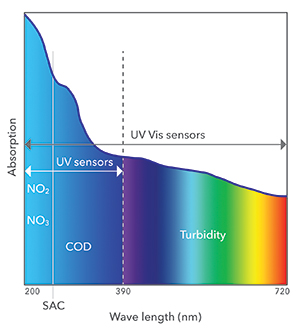 Figure 1. Ultraviolet and visible spectrum of light from 200-720 nm. Nitrate and nitrate primarily absorb UV light from 200-250 nm and organic molecules from 250-350 nm. Turbidity absorbs light from 380-720 nm.
Figure 1. Ultraviolet and visible spectrum of light from 200-720 nm. Nitrate and nitrate primarily absorb UV light from 200-250 nm and organic molecules from 250-350 nm. Turbidity absorbs light from 380-720 nm.
However, there are two single-wavelength sensors that use the absorbance of one wavelength to determine the concentration of a particular parameter. The UVT-254 sensor (or SAC-254) measures the transmission or absorbance (%) of light at the 254nm wavelength. Ultraviolet light at 254nm is absorbed by organic molecules, making this sensor useful for trending organics concentration within drinking water and wastewater. With the UVT-254 sensor, a correlated value of COD, BOD, and TOC can be reported with an accurate calibration and a second wavelength (550nm) is measured for turbidity correction. The NOx sensor measures the sum of nitrate (NO3-N) and nitrite (NO2-N) using a single wavelength which can be sufficient for monitoring nitrogen in some biological nutrient removal applications.
Although single-wavelength sensors can provide useful data and trending, they are limited in accuracy and repeatability compared to the spectral sensors. With the single-wavelength measurement and turbidity correction, these sensors may not detect some forms of organic molecules, can not differentiate between nitrate/nitrite, and do not compensate for turbidity as accurately.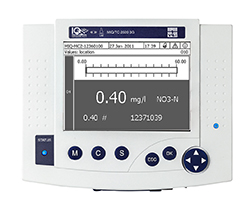
The single-wavelength and spectral sensors both provide benefits, so which is best for your application? The single-wavelength sensors can provide trending for organics or NOx at a moderate price, and there are even applications that specifically utilize single-wavelength sensors, such as UVT-254 for UV disinfection. However, the spectral sensors are calibrated to specific applications (influent, secondary treatment, effluent) and because they scan 256 wavelengths, they provide higher accuracy, higher repeatability, and better correction for turbidity than single-wavelength sensors.
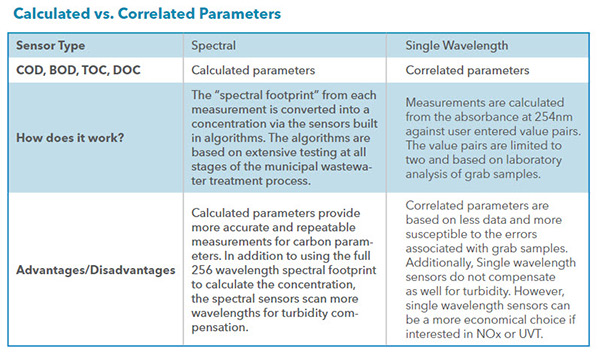
3) What's the Path Length and Why Is It Important?
Path length, or distance between the light source and detector, is important to the spectrophotometric measurement. Path length (aka gap width) is a factor in the calculation of absorbance according to the Beer-Lambert law and is affected greatly by the turbidity of the sample water. For that reason, UV Vis sensors usually have fixed path lengths and provide different gaps for specific applications.
The IQ SensorNet UV Vis sensors have 2 choices for path length: 1 mm and 5 mm (Figure 2). The 1 mm gap is for monitoring untreated wastewater and secondary treatment due to the high turbidity that is typical of these applications. The 5 mm gap is for monitoring treated effluent, wastewater with low turbidity, and can sometimes be adapted to some surface water or drinking water applications. Other manufacturers can have gap lengths of 10-50 mm gap lengths depending on the type of application. When choosing a YSI UV Vis sensor, choose the 701 style sensor for a 1mm path length (untreated wastewater or activated sludge) or the 705 style sensor for the 5 mm path length (low turbidity treated effluent).
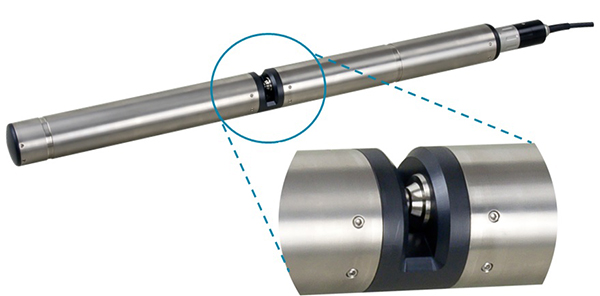
Figure 2. YSI UV Vis sensors have two available gap lengths, 1 mm and 5 mm.
4) How Will I Mount My UV Vis Sensor?
UV Vis sensors are typically larger and heavier than other online sensors and special consideration must be taken when deciding between mounting options. Same as with all online sensors, location and sensor mounting should be chosen based on safety and accessibility. Sensors will need to be easily reached for occasional maintenance, so it is important to have plenty of space to work with the sensor.
Mount the sensor in locations that meet the required safety standards for hand railings and walkways. Along the same lines, the mount for UV Vis sensors should be easy to use and allow for easy maneuverability of the sensor. Finally, since the sensors can be heavier, a mount that is robust and able to handle the weight is very important, especially for wastewater facilities with ragging issues.
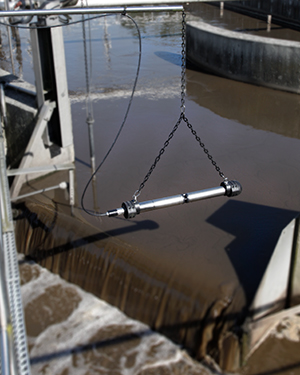 The most common way to mount UV Vis sensors in wastewater is with immersion mounting. Immersion mounting provides direct measurement of the process water by submerging the sensor directly into a basin or stream.
The most common way to mount UV Vis sensors in wastewater is with immersion mounting. Immersion mounting provides direct measurement of the process water by submerging the sensor directly into a basin or stream.
There are two options for immersion mounting YSI UV Vis sensors: a rigid mount or swing/chain mount. Rigid mounts involve fixing the UV Vis sensor to a metal pole and then mounting to either a railing or wall. This type of mount is best when a more robust solution is needed, for example, if the water is turbulent or has ragging. For typical immersion mounting applications, a swing and chain mount can provide several benefits. This type of mount provides better ease of use, as the sensor is suspended at the end of a chain and is simply raised or lowered into the basin with the chain. The swing arm extends the sensor out across the basin, but can be easily accessed by swinging the sensor closer to the railing to remove the sensor for maintenance.
For clean water applications such as treated wastewater effluent, water reuse, or drinking water, a flow-thru cell may be the best option. Immersion mounting may not be possible in these applications due to lack of suitable location or NSF requirements. With a flow-thru cell, the UV Vis sensor is wall mounted and the cell creates a chamber for water to flow across the optical window. Flow is continuously brought to the sensor for measurement and then drained. Whether you are using a YSI UV Vis sensor for clean water or dirty water, choosing the best mounting option for the application will ensure the sensor operates correctly and keeps the required maintenance to a minimum.
5) What are the Maintenance Requirements?
Although UV Vis sensors are light on maintenance and do not require reagents, they still require occasional attention for optimal operation.  The YSI UV Vis sensors have the huge benefit of requiring the least amount of maintenance compared to other online sensors. These sensors have built-in UltraClean technology, a unique and automatic ultrasonic cleaning system. This system not only helps keep the measuring windows cleaner for longer, but the system is also entirely internal to the sensor, so there are no seals or wipers to replace.
The YSI UV Vis sensors have the huge benefit of requiring the least amount of maintenance compared to other online sensors. These sensors have built-in UltraClean technology, a unique and automatic ultrasonic cleaning system. This system not only helps keep the measuring windows cleaner for longer, but the system is also entirely internal to the sensor, so there are no seals or wipers to replace.
Maintaining a clean UV Vis sensor is vital to sensor performance. For this reason, UV Vis sensors often have automatic cleaning systems, which are effective in reducing the overall time required to maintain the sensor. YSI offers two types of automatic cleaning systems: UltraClean which is built-in to all sensors and secondary air blast cleaning systems. The UltraClean ultrasonic cleaning system subtly vibrates the optical windows of the sensor, dislodging any solids building up. This technology has proven to be very successful in wastewater applications with high solids and is also utilized on YSI’s ViSolid (TSS) and VisoTurb (turbidity) sensors. The other option for automatic cleaning of YSI UV Vis sensors is an air blast system.
This system uses an air compressor to periodically force pressurized air over the optical windows, removing any solids that could disrupt the measurement. The YSI air blast system links directly to the sensor and is programmable within the controller to clean at a desired interval. Both automatic cleaning systems are capable of keeping sensors reading accurately for several weeks within wastewater applications.
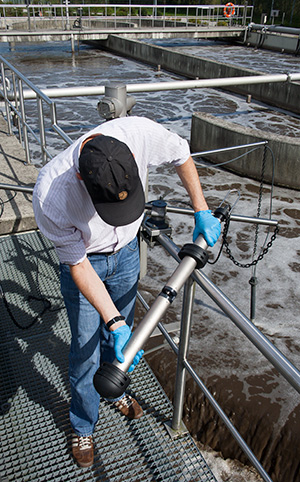 Automatic cleaning systems are great for reducing overall maintenance time, but occasional manual cleanings are still required for optimal performance. Removing the UV Vis sensor from the process every two weeks for a manual cleaning goes a long way in reducing potential measurement issues. Manual cleaning is a quick 1 minute procedure that involves flushing out the measuring gap with clean water, applying a cleaning solution, polishing the lens with a soft cloth, and rinsing thoroughly. Furthermore, keeping a routine maintenance schedule ensures a clean sensor.
Automatic cleaning systems are great for reducing overall maintenance time, but occasional manual cleanings are still required for optimal performance. Removing the UV Vis sensor from the process every two weeks for a manual cleaning goes a long way in reducing potential measurement issues. Manual cleaning is a quick 1 minute procedure that involves flushing out the measuring gap with clean water, applying a cleaning solution, polishing the lens with a soft cloth, and rinsing thoroughly. Furthermore, keeping a routine maintenance schedule ensures a clean sensor.
Another aspect of maintenance is calibration and verification. Calibration for YSI UV Vis sensors is performed using lab reference samples, which are used to adjust the slope correlating the sensor’s raw signal to the concentration value. As previously mentioned, the spectral sensors are factory calibrated to specific applications, but they can be calibrated to adapt the sensor’s measurements to the process water. The single-wavelength sensors can also be calibrated for their main parameters, but the correlated values (BOD, TSS, TOC etc.) must be calibrated to be accurate to lab measurements.
Calibration is performed as needed, such as when a sensor is first installed, moved to a new location, or the sensor is inaccurate to reference samples. YSI UV Vis sensors have a dual channel measuring system, in which an identical reference channel monitors and corrects for aging in the lamp or detector, preventing any potential calibration drift in the sensor. This makes routine calibrations unnecessary, however routine verification of the sensor measurement using a lab reference is recommended to ensure the accuracy of the sensor.

References
Smith, R. (2019). UV Vis Spectrophotometric Sensors for Wastewater Treatment Process Monitoring [White paper]. Retrieved February 17th 2019 from YSI, Inc: http://info.xylem.com/YSI-UV-Vis-Spectrophotometric-Sensors.html
APHA. (1995) Standard Methods for the Examination of Water and Wastewater, 19th edn. American Public Health Association, Washington, DC
Additional Blog Posts of Interest
Wastewater Nutrient Removal Helps Preserve the Chesapeake Bay
How to Control Activated Sludge with Online Sensors
How to Control Denitrification Using Online Sensors
Implementation of Solids Retention Time Control in Wastewater Treatment